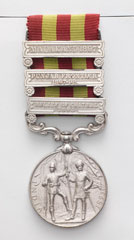
Online Collection
Indian Meritorious Service Medal with three clasps, 'Relief of Chitral 1895', 'Malakand 1897' and 'Punjab Frontier 1897-98', Havildar Biaz, The Queen's Own Corps of Guides, Punjab Frontier Force
Silver medal with, on the obverse, a portrait of Queen Victoria wearing crown and veil, with the inscription, 'Victoria Regina et Imperatrix' (Victoria Queen and Empress). On the reverse, designed by George William De Saulles (1862-1903), the figures of an Indian sepoy and a British soldier holding a standard, with the inscription, 'India' and date '1895'. The campaign medal is suspended on a red and green striped ribbon, with three campaign clasps, 'Relief of Chitral 1895', 'Malakand 1897' and 'Punjab Frontier 1897-98'.
The fort at Chitral was the scene of an epic siege in March 1895. The British had sent a force there from Gilgit under the command of the political agent Surgeon Major George Robertson to oversee the transition of power in Chitral after a ruler was murdered. His endeavours were unsuccessful and an uprising began. It was led by Umra Khan, a Pathan chief from Bajour who used the succession crisis as an excuse to interfere in Chitrali affairs. Robertson and his men retreated to the fort which was promptly besieged by local tribesmen. After six weeks a relief column led by Major General Sir Robert Low rescued the 350 Indian troops at the isolated fort.
In 1897 an uprising broke out along the North West Frontier. Pathan tribesmen attacked the fort at Malakand which guarded the Chitral road. An estimated 12,000 tribesmen surrounded Malakand, and the neighbouring fort of Chakdara. The garrisons, Indian troops commanded by British officers, held out and were relieved after a week of day and night assaults. A Field Force of three brigades was then formed under General Sir Bindon Blood to mount punitive expeditions against the local tribesmen.
The clasp 'Punjab Frontier 1897-98' was awarded to service personnel who were involved in the operations in Tirah and around Peshawar following a rising on the frontier in 1897.
The India Medal, introduced in 1896, replaced the India General Service Medal which had been awarded for various minor campaigns on the subcontinent since 1854. Clasps were awarded for the following engagements: 'Defence of Chitral 1895', 'Relief of Chitral 1895', 'Punjab Frontier 1897-98', 'Malakand 1897', 'Samana 1897', 'Tirah 1897-98', and 'Waziristan 1901-02'.
From a medal group awarded to Havildar Biaz, Queen's Own Corps of Guides, Punjab Frontier Force.
NAM Accession Number
NAM. 1961-12-147-2
Copyright/Ownership
National Army Museum Copyright
Location
National Army Museum, Global Role gallery
Object URL
https://collection.nam.ac.uk/detail.php?acc=1961-12-147-2


